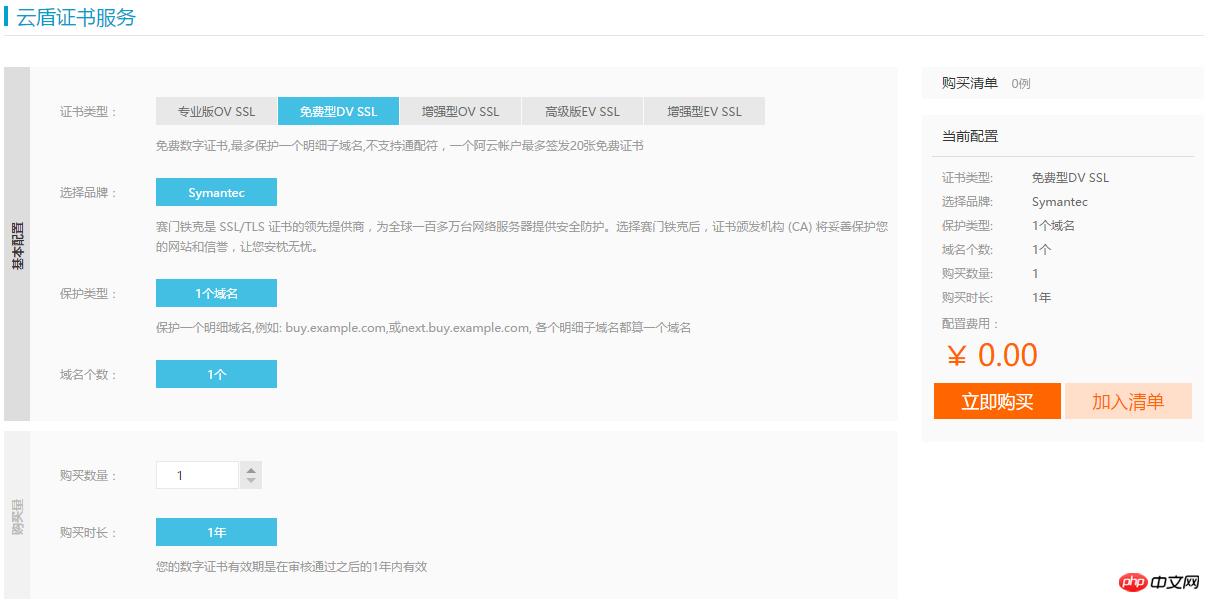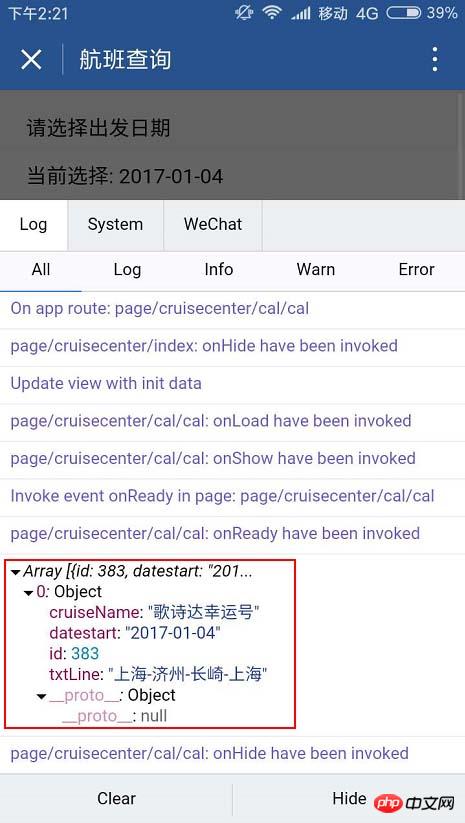 WeChat Applet
WeChat Applet
 Mini Program Development
Mini Program Development
 Introduction to setting up the WeChat applet to access the node.js interface server
Introduction to setting up the WeChat applet to access the node.js interface server
Introduction to setting up the WeChat applet to access the node.js interface server
This article mainly shares with you the tutorial on setting up the WeChat applet to access the node.js interface server. The introduction in the article is very detailed and has certain reference value for everyone. Friends who need it can take a look below.
Preface
Recently I am developing a mini program for WeChat’s application account. The background data interface of the mini program requires https secure requests, so I need The nodejs server can provide https support. Now let’s talk about the entire https server building process.
The building tutorial is as follows:
First of all, I tried the previous expired certificate, and it worked fine when simulated in the developer tools. When testing the access interface on a mobile phone, the wx.request of the WeChat applet will report an SSL handshake failure error (request error : request: fail ssl hand shake error), so you can only reapply for a certificate. It is recommended to use Alibaba Cloud's Symantec SSL/TLS certificate, which is supported by WeChat and can be applied for free for one year.

Symantec SSL Certificate Application
After the application is completed, the review period is usually 1 to 3 days. You can download the certificate file. We choose other categories. The certificate

#The directory after decompression is as shown below. The files we need to use are the first and second files, which are our private key files.

Then we need to build our https server. Here we use the https module that comes with nodejs
var https = require('https')
,fs = require("fs");
var express = require('express');
var app = express();
var options = {
key: fs.readFileSync('./213988289600767.key'),
cert: fs.readFileSync('./213988289600767.pem')
};
https.createServer(options, app).listen(8081, function () {
console.log('Https server listening on port ' + 8081);
});
Please note at this time: WeChat’s mini program only supports domain name interfaces without ports, and does not support IP addresses and interfaces, so we need to map to port 80 Only a registered domain name can be accessed by the WeChat applet.
Finally we can access our nodejs server interface through the wx.request method.

Printing interface data in real machine debugging mode
The above is the entire content of this article. I hope it will be helpful to everyone's learning. For more related content, please pay attention to PHP Chinese net!
Related recommendations:
About the encapsulation of the WeChat applet request interface
About the WeChat applet location API interface Parse
The above is the detailed content of Introduction to setting up the WeChat applet to access the node.js interface server. For more information, please follow other related articles on the PHP Chinese website!

Hot AI Tools

Undresser.AI Undress
AI-powered app for creating realistic nude photos

AI Clothes Remover
Online AI tool for removing clothes from photos.

Undress AI Tool
Undress images for free

Clothoff.io
AI clothes remover

AI Hentai Generator
Generate AI Hentai for free.

Hot Article

Hot Tools

Notepad++7.3.1
Easy-to-use and free code editor

SublimeText3 Chinese version
Chinese version, very easy to use

Zend Studio 13.0.1
Powerful PHP integrated development environment

Dreamweaver CS6
Visual web development tools

SublimeText3 Mac version
God-level code editing software (SublimeText3)

Hot Topics
 1385
1385
 52
52
 The difference between nodejs and vuejs
Apr 21, 2024 am 04:17 AM
The difference between nodejs and vuejs
Apr 21, 2024 am 04:17 AM
Node.js is a server-side JavaScript runtime, while Vue.js is a client-side JavaScript framework for creating interactive user interfaces. Node.js is used for server-side development, such as back-end service API development and data processing, while Vue.js is used for client-side development, such as single-page applications and responsive user interfaces.
 Is nodejs a backend framework?
Apr 21, 2024 am 05:09 AM
Is nodejs a backend framework?
Apr 21, 2024 am 05:09 AM
Node.js can be used as a backend framework as it offers features such as high performance, scalability, cross-platform support, rich ecosystem, and ease of development.
 How to connect nodejs to mysql database
Apr 21, 2024 am 06:13 AM
How to connect nodejs to mysql database
Apr 21, 2024 am 06:13 AM
To connect to a MySQL database, you need to follow these steps: Install the mysql2 driver. Use mysql2.createConnection() to create a connection object that contains the host address, port, username, password, and database name. Use connection.query() to perform queries. Finally use connection.end() to end the connection.
 What is the difference between npm and npm.cmd files in the nodejs installation directory?
Apr 21, 2024 am 05:18 AM
What is the difference between npm and npm.cmd files in the nodejs installation directory?
Apr 21, 2024 am 05:18 AM
There are two npm-related files in the Node.js installation directory: npm and npm.cmd. The differences are as follows: different extensions: npm is an executable file, and npm.cmd is a command window shortcut. Windows users: npm.cmd can be used from the command prompt, npm can only be run from the command line. Compatibility: npm.cmd is specific to Windows systems, npm is available cross-platform. Usage recommendations: Windows users use npm.cmd, other operating systems use npm.
 What are the global variables in nodejs
Apr 21, 2024 am 04:54 AM
What are the global variables in nodejs
Apr 21, 2024 am 04:54 AM
The following global variables exist in Node.js: Global object: global Core module: process, console, require Runtime environment variables: __dirname, __filename, __line, __column Constants: undefined, null, NaN, Infinity, -Infinity
 Is there a big difference between nodejs and java?
Apr 21, 2024 am 06:12 AM
Is there a big difference between nodejs and java?
Apr 21, 2024 am 06:12 AM
The main differences between Node.js and Java are design and features: Event-driven vs. thread-driven: Node.js is event-driven and Java is thread-driven. Single-threaded vs. multi-threaded: Node.js uses a single-threaded event loop, and Java uses a multi-threaded architecture. Runtime environment: Node.js runs on the V8 JavaScript engine, while Java runs on the JVM. Syntax: Node.js uses JavaScript syntax, while Java uses Java syntax. Purpose: Node.js is suitable for I/O-intensive tasks, while Java is suitable for large enterprise applications.
 Is nodejs a back-end development language?
Apr 21, 2024 am 05:09 AM
Is nodejs a back-end development language?
Apr 21, 2024 am 05:09 AM
Yes, Node.js is a backend development language. It is used for back-end development, including handling server-side business logic, managing database connections, and providing APIs.
 How to deploy nodejs project to server
Apr 21, 2024 am 04:40 AM
How to deploy nodejs project to server
Apr 21, 2024 am 04:40 AM
Server deployment steps for a Node.js project: Prepare the deployment environment: obtain server access, install Node.js, set up a Git repository. Build the application: Use npm run build to generate deployable code and dependencies. Upload code to the server: via Git or File Transfer Protocol. Install dependencies: SSH into the server and use npm install to install application dependencies. Start the application: Use a command such as node index.js to start the application, or use a process manager such as pm2. Configure a reverse proxy (optional): Use a reverse proxy such as Nginx or Apache to route traffic to your application



